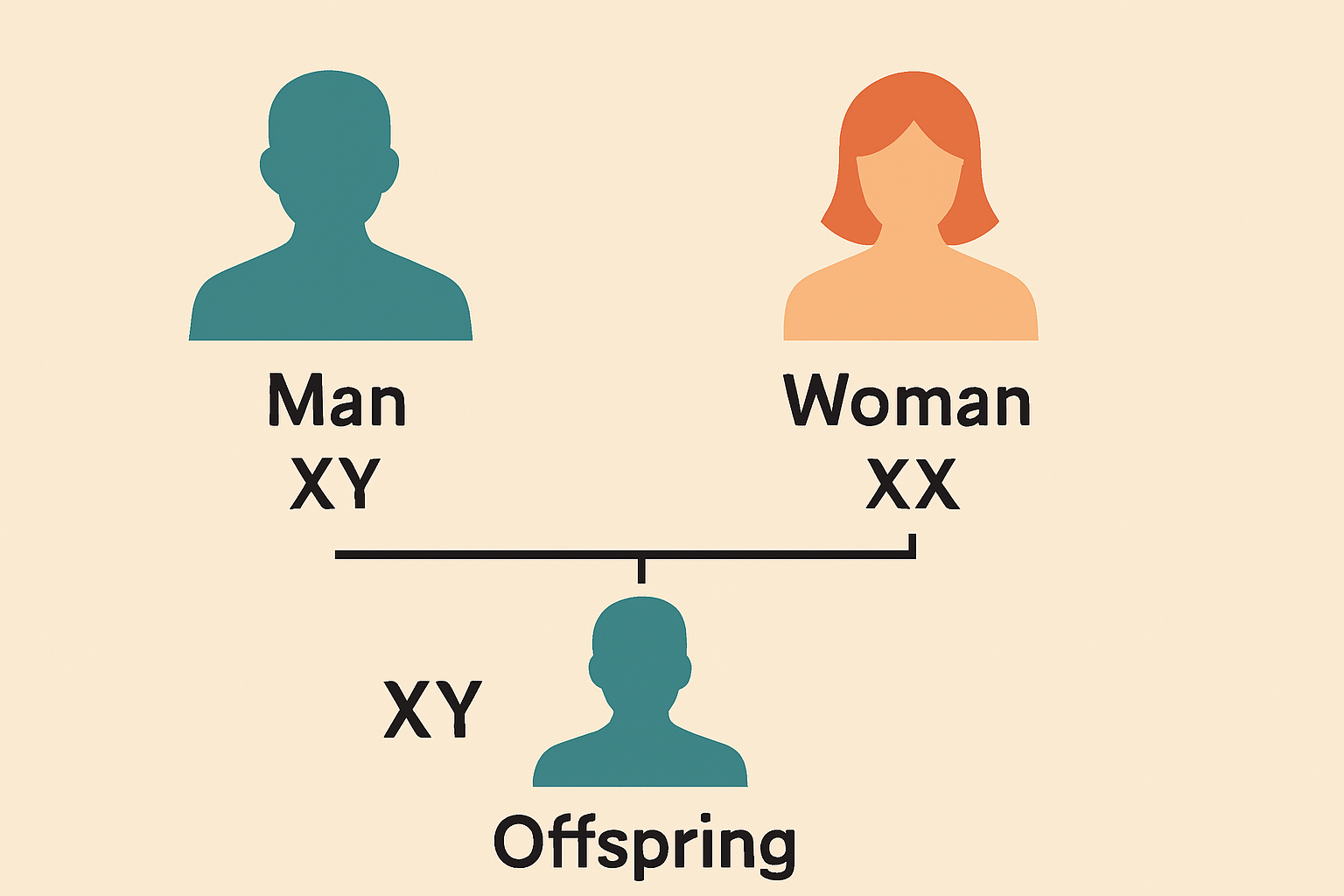 When the father donates his Y, then the mother X, the offspring becomes XY. Any child that has XY chromosome is a male genetically and develops male body parts. But in rare cases the physical body features are all female.
When the father donates his Y, then the mother X, the offspring becomes XY. Any child that has XY chromosome is a male genetically and develops male body parts. But in rare cases the physical body features are all female.For teenage girls, the right of passage into womanhood is straightforward –pimples in the face, periods arriving, breasts filling out – but a few Kenyan girls, never go through this. Thanks to a medical condition called Swyer Syndrome, these girls have been genetically male all their entire lives without knowing it. DR CHRISTIAN OMOAGHE, a consultant endocrinologist based at the MP Shah Hospital in Nairobi, recently attended to a girl who has lived genetically as a male for 19 years. Although outwardly she's female, she has no ovaries but has now been placed on hormone treatment. The case is reported in the Willey Case Reports journal. Dr Omoaghe, who helped three other clients in Kisumu, has also researched widely and published on the topic. He spoke with Star’s JOHN MUCHANGI.
Question: How do you explain this situation where someone can be physically a woman but genetically male?
Answer: Generally, we take it as given that this is a boy, or this is a girl. But in medicine, we have three types of sex.
First, we have the chromosomal sex. This is the sex the child inherited from the father and the mother, because males and females have two types of sex chromosomes. The male has one X and one Y, while the female has two X chromosomes.
Every individual inherits a chromosome from each of the parents. So when the father donates his Y, then the mother X, that person becomes XY. Any child that has XY chromosome is a male in terms of chromosomal sex.
A female gets one X from the father and one X from the mother. That’s a female chromosomal sex.
Then we have what we call gonadal sex, also called biological or physical (anatomical) sex. It has to do with the physical organs. When a child gets XY, the Y chromosome makes the body to produce male reproductive organs, things like the testes, penis, scrotum and all that.
That's why we call it anatomical sex. The chromosomal sex has led to anatomical sex of male. For female, the absence of the Y makes the child become X female, that is, develops a vagina, vulva, then little breasts. So generally in medicine, every child is a female, except there is a Y chromosome.
Then we now have what we call gender. Gender is what the society assigns you. So there is a way we rear boys and there is a way we rear girls. This is how a boy behaves, this is how a boy moves, wears male clothes. So his gender is a man or a boy or a girl.
So if a child has XY, it becomes a boy, and develops into a man. But sometimes there may be clashes where a child has XY, but he is born a girl, with the anatomical features of a girl.
Or a child has XX, but born with things that look like a penis and all that, and is reared a male.
So that is where disorders of sex differentiation comes in.
So Swyer Syndrome is the group of these disorders where the person has XY, should have been a male, but was born with female genitals, like this particular patient. I would say “she”, because in terms of gender now, she is now 19.
She has developed breasts, so I cannot call her he. Looking at chromosomal sex only, I would have said he.
She was born with female features. She has grown with female features, so she now has a disconnect between appearance and her chromosomal sex. So that is Swyer Syndrome.
Does
such a person feel a disconnect in their body or is it only when they come
into puberty and they are not menstruating, that they realise there is a problem?
As I said earlier, Swyer Syndrome is one of those conditions where the Y chromosome, for reasons we call mutations, destroys its ability to cause the body to to create testes and produce hormones. The Y is there, but it is not functioning. So by default, the body becomes female. So the child develops as a female.
But unfortunately, because there is still a Y chromosome, she does not develop the full characteristics of a female. For example, she does not have ovaries.
But she has a little womb, a vagina, and she grows towards puberty. There are several hormones that also help a child to develop. Things like the adrenal gland that makes the child grow, develop hair, change voice and all that.
So what is causing these changes are hormones produced by the adrenal gland. The adrenaline gland is near the kidneys, and produces hormones that the body can use to develop.
But the ovaries have an important role. It is the ovaries that make a lady ovulate and menstruate.
Menstruation comes after a lady ovulates. So no ovaries, no ovulation. So the commonest complaint is, the lady notices she has not started menstruating even when all her peers are menstruating. And usually that is what brings them to the hospital.
What challenges do you
face in diagnosing such a condition?
Most of the problems we are facing is getting insurance approvals. When a doctor lists certain hormone tests, for example, oestrogen or testosterone, the first thing the insurance company thinks of is, the person is trying to check for infertility.
Because these are also the hormones that determine if a male or a female will be fertile. For this client, it took a lot of pressure on the insurance before they could allow us to do MRI.
Then, secondly, for them to agree to
cover chromosomal studies. To diagnose chromosomal problems, you have
to do chromosomal studies, which we call karyotyping. It's an expensive test.
The other is awareness. Many times, female children are close to their mothers. So they get only information about their bodies from their mothers.
So it is what their mothers experienced that they take as normal or abnormal. For this patient, the mother started menstruating at the age of 14 or 15, which is a little late. So when she was not menstruating at the age of 14 she didn't see it as a problem because of her mother.
But it was when she was 19 that the mother felt, this is now beyond what I think. So the enlightenment for the public, and especially mothers, because delaying diagnosis has its own implications.
Then finally, enlightenment for the doctors. Maybe because of the paucity of specialists, when doctors get these kinds of bizarre presentations, they usually don't know where to go.
So we need a lot of continuous medical education, especially for the clinical officers, and medical officers, because they usually the first likely to see these patients, and and refer them to specialists.

Dr Christian Omoaghe is a senior Consultant physician/Endocrinologist and head of the Diabetes Care Centre at the MP Shah Hospital in Nairobi.
You mentioned early diagnosis. What happens if someone
does not get early diagnosis?
The first thing is the implications of no ovaries. The ovaries produce oestrogen that helps female development, ovulation, becoming fertile and all that. This hormone is also very important for cardiovascular health. We now know that oestrogen helps the [blood] vessels of females to relax.
That is why men tend to have hypertension more than women. That is why men tend to have heart attacks more than women because they lack this protective oestrogen. So a young lady without ovaries is lacking this relaxing benefits of oestrogen in her vessels.
So she is prone to developing heart issues early in life. The second thing is that oestrogen also helps with bone strength. For men, it is testosterone, but for women, it's oestrogen that helps with bone strength.
So if she has been lacking oestrogen, she is prone to developing brittle bones that break easily. And when she becomes very athletic, she can easily get a fracture. Normally it's because of lack of oestrogen.
Then another issue is this, the ovaries that didn't develop appear as thin threads of tissue. There's evidence to show that those thin threads of tissue can become cancerous.
What's
the importance of hormone therapy replacement therapy?
It introduces oestrogen to the body to confer the benefits of oestrogen. She has not had oestrogen since birth, so the hormone therapy contains oestrogen and progesterone.
It makes her to now fully develop as a woman. Two, it gives her bone strength. So her bone becomes strong and not liable to fractures in life.
Finally, this cardiovascular health. She is not prone to cardiovascular issues because she now has oestrogen.
According to your paper, it's possible for some women with this condition to get pregnant. How can can happen?
For a woman to have a baby, she has to have a source of eggs (the ovaries), the womb, and a conducive environment. These are the three main things. The other is a fertile sperm from the partner.
If one has Swyer, the source of eggs is not there. But now we have different advances in medicine where we can take an egg from a family member.
For example, we take an egg from her sister, then the sperm from the partner, and make cost-effective fertilisation in the lab, and we can grow the baby to a certain size that we can now put in her womb because she has a womb.
Then we can now give all the hormones that the body requires as drugs for the baby to grow.
Sometimes womb is very small, because for years there was no oestrogen. So the hope is that hormone therapy will make the womb develop, but it's possible it may not fully develop. If that happens, the other option is to take the egg of the sister with sperm from the partner and look for a surrogate mother, someone who agrees to carry the baby.
That baby will not have any genetic connection with the surrogate, because we are just renting her womb.
The final option will be adoption.
How common is this condition in Africa?
Unfortunately
for Africa we don't have records. The
most reliable records are
from Europe. Danish studies discovered it’s one in 80,000 people.
It’s rare in Kenya but I worked in Kisumu and before I left, I saw three cases. One of them was a girl child having a penis. Then there was also one who had a testis inside the abdomen but still having a vagina.
If we had the central registry, it would be easy for the Ministry of Health to collate and give us estimated prevalence and all that.
Kenyans know about intersex people, because there's been a lot of advocacy. Is Swyer syndrome same as intersex?
Intersex is the old name for disorders of sexual differentiation of which Swyer syndrome is one. The reason why DSD syndrome came up was because intersex was not explaining all the different presentations we are now seeing. Intersex was initially to explain hermaphrodites only, where somebody is born with both ovary and testes.
Finally, what genetic or environmental factors are known to contribute to this condition?
They have several causes. In Kenya, I think, the driving one is genetics, where the child inherited a defective Y chromosome from the father. For her, this Y chromosome was not able to fully express itself.
Another common thing that drives is gestational hyperandrogenism (having too many male hormones –androgens– in the mother’s blood during pregnancy).
Many women use hormonal contraceptive in Kenya such as injections and pills. Now, unfortunately, contraception is not 100 per cent effective in preventing pregnancy. So if a mother, for example, is on injectable contraceptive and gets pregnant, that injection contains high levels of female hormones.
Once she takes it in, as the baby is developing, the placenta changes the high levels of female hormones flowing from the injection to male hormones. And these male hormones transform a child; if it's a female child, transforms the female child to a male child.
That is one of the problems I've seen where, unfortunately, the woman, still got pregnant while on the pill.
And so whenever you have any suspicion of pregnancy while on contraception, it's good to check it out. Because these hormonal contraceptives, they have an effect.









